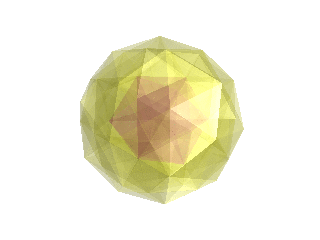Hydrochoron (EntityTopic, 12)
From Hi.gher. Space
The hydrochoron, also known as the hexacosichoron and the 600-cell, is a 4D polytope bounded by 600 tetrahedra, meeting 20 to a vertex, 5 to an edge. It is the 4D equivalent (and the highest dimensional analog) of an icosahedron, and its vertex figure is also an icosahedron.
The hydrochoron can be constructed by raising pyramids on each icosahedral face of the xylochoric snub. This means it can indirectly be constructed from the geochoron.
Coordinates
The coordinates of a hydrochoron with side 2/φ are all permutations and sign changes of:
(1, 1, 1, 1)
(2, 0, 0, 0)
And all even permutations and changes of sign of:
(φ, 1, φ-1, 0)
Equations
- The hypervolumes of a hydrochoron with edge length l are given by:
total edge length = 720l
total surface area = 300√3 · l2
surcell volume = 50√2 · l3
bulk= 25∕4(2+√5) · l4
Projection
Here is a perspective projection of the hexacosichoron to 3D. Around the central vertex, which is closest to the 4D viewpoint, are 20 highlighted tetrahedra, joined in the form of an icosahedron. There are two more layers visible closer to the "surface" of the 3D projection, and another three layers which are mirror images of the first three on the back of the 4D shape.
Relation to other polychora
Grand antiprism
Given two adjacent vertices in the 600-cell, the cells that meet at each vertex define two icosahedra that overlap in precisely 5 tetrahedra. The 5 tetrahedra surround the edge that connects these two vertices. One may identify another set of 5 tetrahedra in the second icosahedron such that they do not share any ridges with these 5 tetrahedra, but do share the second vertex. This second set of 5 tetrahedra is the intersection of the second icosahedron with a third. This gives a third vertex connected to the second, such that the second and third vertices lie on the antipodes of an icosahedron. By repeatedly applying this procedure, one obtains a ring of 10 vertices around the 600-cell, lying on one of its great circles. Another ring of vertices may be obtained in the same way such that the two rings lie on two mutually orthogonal planes. If these two rings of vertices are removed from the 600-cell, the convex hull of the remaining vertices is the grand antiprism.
One method of obtaining the second ring, given the first, makes use of the fact that the two rings corresponds with the two bounding 3-manifolds of the duocylinder. The set of vertices directly connected to (but not including) the first ring of vertices lie on a 2-manifold analogous to the ridge of the duocylinder. The set of vertices directly connected to this set (but excluding the vertices in the first ring) lie on another similar 2-manifold, farther away from the first ring, and closer to the second ring. By iterating this procedure, the manifolds thus obtained will eventually converge onto the second ring. (In fact, only 3 iterations are necessary: the first iteration yields the vertices of one ring of pentagonal antiprisms in the grand antiprism, the second iteration yields the vertices of the other ring of pentagonal antiprisms, and the third iteration yields the second ring.)
Snub 24-cell
Another uniform polychoron may be obtained from the 600-cell by a different diminishing of it: inscribe a 24-cell in a 600-cell such that the 24 vertices of the latter coincide with 24 vertices in the 600-cell, then remove these 24 vertices from the 600-cell and recompute the convex hull of the remaining vertices. The result is the snub 24-cell.
Incidence matrix
Dual: cosmochoron
| # | TXID | Va | Ea | 3a | C1a | Type | Name |
|---|---|---|---|---|---|---|---|
| 0 | Va | = point | ; | ||||
| 1 | Ea | 2 | = digon | ; | |||
| 2 | 3a | 3 | 3 | = triangle | ; | ||
| 3 | C1a | 4 | 6 | 4 | = tetrahedron | ; | |
| 4 | H4.1a | 120 | 720 | 1200 | 600 | = hydrochoron | ; |
Usage as facets
This polytope does not currently appear as facets in any higher-dimensional polytopes in the database.
| Notable Tetrashapes | |
| Regular: | pyrochoron • aerochoron • geochoron • xylochoron • hydrochoron • cosmochoron |
| Powertopes: | triangular octagoltriate • square octagoltriate • hexagonal octagoltriate • octagonal octagoltriate |
| Circular: | glome • cubinder • duocylinder • spherinder • sphone • cylindrone • dicone • coninder |
| Torii: | tiger • torisphere • spheritorus • torinder • ditorus |

